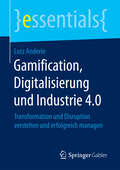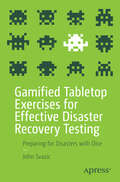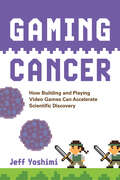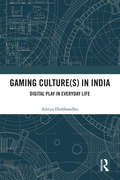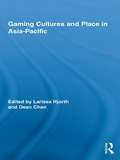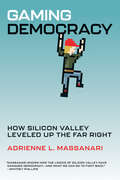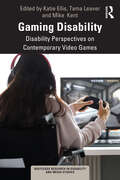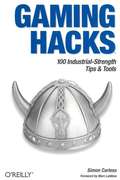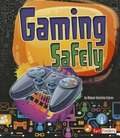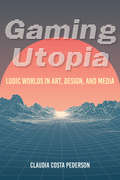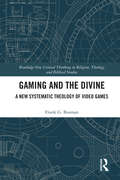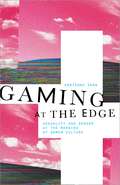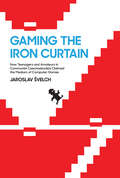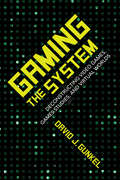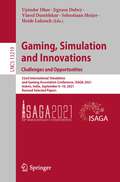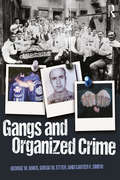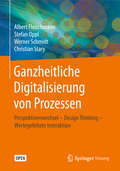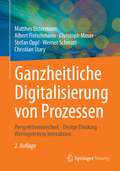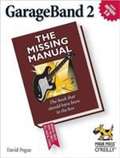- Table View
- List View
Gamification, Digitalisierung und Industrie 4.0: Transformation und Disruption verstehen und erfolgreich managen (essentials)
by Lutz AnderieIn diesem essential wird erl#65533;utert, wie Gamification, Digitalisierung und die vierte industrielle Revolution Gesellschaft, Unternehmensf#65533;hrung und Management ver#65533;ndern. Anhand zahlreicher Grafiken und Abbildungen werden unter anderem die aktuellen Branchenentwicklungen im Hinblick auf Virtual, Augmented und Mixed Reality aufgezeigt. Zukunftstechnologien werden dargelegt, die in der Games Industry entwickelt wurden und Einfluss auf andere Branchen wie beispielsweise die KFZ-Industrie oder das Gesundheitswesen haben. Wertsch#65533;pfungsprozesse f#65533;r Kultur- und Wirtschaftsg#65533;ter werden dokumentiert.
Gamified Tabletop Exercises for Effective Disaster Recovery Testing: Preparing for Disasters with Dice
by John SvazicTabletop exercises are a common way to test disaster recovery and business continuity plans, but they can also be some of the most dry and boring meetings any professional can attend. Following a set script with no variation can cause folks to lose interest and question the value of such exercises, even when they are required for compliance frameworks such as SOC2. What is a security professional to do? Simple—introduce variability by adding dice! Gamification isn't a new idea, but applying some principles of gamification to a traditional tabletop exercise can breathe new life into a potentially monotonous activity. This book covers how to build a gamified tabletop exercise from the ground up, and provides example exercises you can build upon for your own needs. Not only will participation improve, but you will have reusable exercises to work with as each walk-through can produce different results, helping to cover multiple outcomes when testing your recovery capabilities. By providing examples and a methodical approach on how to build gamification into a traditional tabletop, the goal is to provide a new perspective on tabletop exercises that should be more engaging for all participants, and thus more beneficial for everyone involved. Avoid the monotony and start practicing with realistic consequences for decisions with dice rolls! What You Will Learn Plan, build, and execute tabletop exercises with participants Understand and explain gamification benefits and how to add it to traditional tabletop exercises Understand why and how to introduce such concepts to a traditional tabletop exercise Get up to speed on the purpose of tabletop exercises as well as how to improve participation and retention of exercise participants Compile tips and tricks to help when encountering unexpected issues during tabletop exercises, from unexpected decisions to difficult participants Know tools and techniques, such as using mind maps, to help plan and build gamified tabletop exercises Who This Book Is For GRC or security professionals who would are responsible for executing a tabletop exercise or otherwise tasked with annual testing of the company disaster recovery/business continuity plans. Even participants who are looking for alternatives to traditional "happy path" tabletops may be interested.
Gaming Cancer: How Building and Playing Video Games Can Accelerate Scientific Discovery
by Jeff YoshimiCan experimenting with game design increase our chances of finding a cure for cancer?Cancer is crafty, forcing us to be just as clever in our efforts to outfox it—and we&’ve made excellent progress, but is it time for a new play in the playbook? In Gaming Cancer, Jeff Yoshimi proposes a new approach to fighting an increasingly exhausting war. By putting the work of cancer research into the hands of nonspecialists, Yoshimi believes, we can accelerate the process of outgaming the disease once and for all.Gamers have already used &“serious games&” to discover new galaxies, digitize ancient texts, decode viruses, and solve theoretical problems in neuroscience. Cancer is a multilayered threat, and our best bet at overcoming it is via more minds working in concert. Gaming Cancer is an instruction manual for engineering games that motivate users to strain and sweat to find cancer cures. It integrates game design with research in cancer biology, data visualization techniques, and developments in cognitive science and AI while remaining sensitive to the limitations of citizen science and ethical concerns. Yoshimi sees in cutting-edge game technology the potential to educate and empower people to outwit cancer, an indirect route to richer science literacy that draws on the boundless resources of the mind.This book offers anyone invested in beating this seemingly intractable disease a concrete playbook that combines real science with creative vision in an effort to defeat the boss monster, cancer.
Gaming Culture(s) in India: Digital Play in Everyday Life
by Aditya DeshbandhuThis volume critically analyzes the multiple lives of the "gamer" in India. It explores the "everyday" of the gaming life from the player’s perspective, not just to understand how the games are consumed but also to analyze how the gamer influences the products’ many (virtual) lives. Using an intensive ethnographic approach and in-depth interviews, this volume situates the practice of gaming under a broader umbrella of digital leisure activities and foregrounds the proliferation of gaming as a new media form and cultural artifact; critically questions the term gamer and the many debates surrounding the gamer tag to expand on how the gaming identity is constructed and expressed; details participants’ gaming habits, practices and contexts from a cultural perspective and analyzes the participants’ responses to emerging industry trends, reflections on playing practices and their relationships to friends, communities and networks in gaming spaces; and examines the offline and online spaces of gaming as sites of contestation between developers of games and the players. A holistic study covering one of the largest video game bases in the world, this volume will be of great interest to scholars and researchers of cultural studies, media and communication studies and science and technology studies, as well as be of great appeal to the general reader.
Gaming Cultures and Place in Asia-Pacific (Routledge Studies in New Media and Cyberculture)
by Larissa Hjorth Dean ChanThis collection explores the relationship between digital gaming and its cultural context by focusing on the burgeoning Asia-Pacific region. Encompassing key locations for global gaming production and consumption such as Japan, China, and South Korea, as well as increasingly significant sites including Australia and Singapore, the region provides a wealth of divergent examples of the role of gaming as a socio-cultural phenomenon. Drawing from micro ethnographic studies of specific games and gaming locales to macro political economy analyses of techno-nationalisms and trans-cultural flows, this collection provides an interdisciplinary model for thinking through the politics of gaming production, representation, and consumption in the region.
Gaming Democracy: How Silicon Valley Leveled Up the Far Right
by Adrienne L. MassanariHow play and gaming culture have mainstreamed far right ideology through social media platforms.From #Gamergate to the ongoing Big Lie, the far right has gone mainstream. In Gaming Democracy, Adrienne Massanari tracks the flames of toxicity found in the far right and &“alt-right&” movements as they increasingly take up oxygen in American and global society. In this pathbreaking contribution to the fields of internet studies, game studies, and gender studies, Massanari argues that Silicon Valley&’s emphasis on meritocracy and free speech absolutism has driven this rightward slide. These ideologies have been coded into social media spaces that implicitly silence marginalized communities and subject them to rampant abuse by groups that have learned to &“game&” the ecology of platforms, algorithms, and attention economies.While populist movements are not new, phenomena such as QAnon, parental rights activism, and COVID denialism are uniquely &“of the internet,&” with supporters demonstrating both technical acumen and an ability to use memes and play as a way of both building community and fomenting dissent. Massanari explores the ways that the far right uses memetic humor and geek masculinity as tools both to create a sense of community within these leaderless groups and to obfuscate their intentions. Using the lens of play and game studies as well as the concept of &“metagaming,&” Gaming Democracy is a novel contribution to our understanding of online platforms and far right political activism.
Gaming Disability: Disability Perspectives on Contemporary Video Games (Routledge Research in Disability and Media Studies)
by Katie Ellis Mike Kent Tama LeaverThis book explores the opportunities and challenges people with disabilities experience in the context of digital games from the perspective of three related areas: representation, access and inclusion, and community. Drawing on key concerns in disability media studies, the book brings together scholars from disability studies and game studies, alongside game developers, educators, and disability rights activists, to reflect upon the increasing visibility of disabled characters in digital games. Chapters explore the contemporary gaming environment as it relates to disability on platforms such as Twitch, Minecraft, and Tingyou, while also addressing future possibilities and pitfalls for people with disabilities within gaming given the rise of virtual reality applications, and augmented games such as Pokémon Go. The book asks how game developers can attempt to represent diverse abilities, taking games such as BlindSide and Overwatch as examples. A significant collection for scholars and students interested in the critical analysis of digital games, this volume will be of interest across several disciplines including game studies, game design and development, internet, visual, cultural, communication and media studies, as well as disability studies.
Gaming Hacks
by Simon CarlessIt doesn't take long for an avid or just wickedly clever gamer to be chafed by the limitations of videogame software or hardware. If you want to go far beyond the obvious, there's an awful lot of free fun you can have, using the creative exploits of the gaming gurus. Gaming Hacks is the indispensable guide to cool things gamers can do to create, modify, and hack videogame hardware and software.
Gaming Representation: Race, Gender, and Sexuality in Video Games
by Treaandrea M. Russworm Jennifer MalkowskiRecent years have seen an increase in public attention to identity and representation in video games, including journalists and bloggers holding the digital game industry accountable for the discrimination routinely endured by female gamers, queer gamers, and gamers of color. Video game developers are responding to these critiques, but scholarly discussion of representation in games has lagged far behind. Gaming Representation examines portrayals of race, gender, and sexuality in a range of games, from casuals like Diner Dash, to indies like Journey and The Binding of Isaac, to mainstream games from the Grand Theft Auto, BioShock, Spec Ops, The Last of Us, and Max Payne franchises. Arguing that representation and identity function as systems in games that share a stronger connection to code and platforms than it may first appear, the contributors to this volume push gaming scholarship to new levels of inquiry, theorizing, and imagination.
Gaming Safely
by Frank W. Baker Allyson Valentine SchrierIf a strange character offers you a gift in an online game, do you know what to do? Don't worry if you don't. This book is here to help! Learn tech-savvy ways to keep your game sites safe sites without taking away all the fun!
Gaming Utopia: Ludic Worlds in Art, Design, and Media
by Claudia Costa PedersonIn Gaming Utopia: Ludic Worlds in Art, Design, and Media, Claudia Costa Pederson analyzes modernist avant-garde and contemporary video games to challenge the idea that gaming is an exclusively white, heterosexual, male, corporatized leisure activity and reenvisions it as a catalyst for social change. By looking at over fifty projects that together span a century and the world, Pederson explores the capacity for sociopolitical commentary in virtual and digital realms and highlights contributions to the history of gaming by women, queer, and transnational artists. The result is a critical tool for understanding video games as imaginative forms of living that offer alternatives to our current reality. With an interdisciplinary approach, Gaming Utopia emphasizes how game design, creation, and play can become political forms of social protest and examines the ways that games as art open doors to a more just and peaceful world.
Gaming and the Divine: A New Systematic Theology of Video Games (Routledge New Critical Thinking in Religion, Theology and Biblical Studies)
by Frank G. BosmanThis book formulates a new theological approach to the study of religion in gaming. Video games have become one of the most important cultural artifacts of modern society, both as mediators of cultural, social, and religious values and in terms of commercial success. This has led to a significant increase in the critical analysis of this relatively new medium, but theology as an academic discipline is noticeably behind the other humanities on this subject. The book first covers the fundamentals of cultural theology and video games. It then moves on to set out a Christian systematic theology of gaming, focusing on creational theology, Christology, anthropology, evil, moral theology, and thanatology. Each chapter introduces case studies from video games connected to the specific theme. In contrast to many studies which focus on online multiplayer games, the examples considered are largely single player games with distinct narratives and ‘end of game’ moments. The book concludes by synthesizing these themes into a new theology of video games. This study addresses a significant aspect of contemporary society that has yet to be discussed in any depth by theologians. It is, therefore, a fantastic resource for any scholar engaging with the religious aspects of digital and popular culture.
Gaming at the Edge: Sexuality and Gender at the Margins of Gamer Culture
by Adrienne ShawVideo games have long been seen as the exclusive territory of young, heterosexual white males. In a media landscape dominated by such gamers, players who do not fit this mold, including women, people of color, and LGBT people, are often brutalized in forums and in public channels in online play. Discussion of representation of such groups in games has frequently been limited and cursory. In contrast, Gaming at the Edge builds on feminist, queer, and postcolonial theories of identity and draws on qualitative audience research methods to make sense of how representation comes to matter. In Gaming at the Edge, Adrienne Shaw argues that video game players experience race, gender, and sexuality concurrently. She asks: How do players identify with characters? How do they separate identification and interactivity? What is the role of fantasy in representation? What is the importance of understanding market logic? In addressing these questions Shaw reveals how representation comes to matter to participants and offers a perceptive consideration of the high stakes in politics of representation debates. Putting forth a framework for talking about representation, difference, and diversity in an era in which user-generated content, individualized media consumption, and the blurring of producer/consumer roles has lessened the utility of traditional models of media representation analysis, Shaw finds new insight on the edge of media consumption with the invisible, marginalized gamers who are surprising in both their numbers and their influence in mainstream gamer culture.
Gaming the Iron Curtain: How Teenagers and Amateurs in Communist Czechoslovakia Claimed the Medium of Computer Games (Game Histories)
by Jaroslav SvelchHow amateur programmers in 1980s Czechoslovakia discovered games as a medium, using them not only for entertainment but also as a means of self-expression.Aside from the exceptional history of Tetris, very little is known about gaming culture behind the Iron Curtain. But despite the scarcity of home computers and the absence of hardware and software markets, Czechoslovakia hosted a remarkably active DIY microcomputer scene in the 1980s, producing more than two hundred games that were by turns creative, inventive, and politically subversive. In Gaming the Iron Curtain, Jaroslav Švelch offers the first social history of gaming and game design in 1980s Czechoslovakia, and the first book-length treatment of computer gaming in any country of the Soviet bloc. Švelch describes how amateur programmers in 1980s Czechoslovakia discovered games as a medium, using them not only for entertainment but also as a means of self-expression. Sheltered in state-supported computer clubs, local programmers fashioned games into a medium of expression that, unlike television or the press, was neither regulated nor censored. In the final years of Communist rule, Czechoslovak programmers were among the first in the world to make activist games about current political events, anticipating trends observed decades later in independent or experimental titles. Drawing from extensive interviews as well as political, economic, and social history, Gaming the Iron Curtain tells a compelling tale of gaming the system, introducing us to individuals who used their ingenuity to be active, be creative, and be heard.
Gaming the System: Deconstructing Video Games, Games Studies, and Virtual Worlds (Digital Game Studies)
by David J. GunkelGaming the System takes philosophical traditions out of the ivory tower and into the virtual worlds of video games. In this book, author David J. Gunkel explores how philosophical traditions—put forth by noted thinkers such as Plato, Descartes, Kant, Heidegger, and Žižek—can help us explore and conceptualize recent developments in video games, game studies, and virtual worlds. Furthermore, Gunkel interprets computer games as doing philosophy, arguing that the game world is a medium that provides opportunities to model and explore fundamental questions about the nature of reality, personal identity, social organization, and moral conduct. By using games to investigate and innovate in the area of philosophical thinking, Gunkel shows how areas such as game governance and manufacturers’ terms of service agreements actually grapple with the social contract and produce new postmodern forms of social organization that challenge existing modernist notions of politics and the nation state. In this critically engaging study, Gunkel considers virtual worlds and video games as more than just "fun and games," presenting them as sites for new and original thinking about some of the deepest questions concerning the human experience.
Gaming, Simulation and Innovations: 52nd International Simulation and Gaming Association Conference, ISAGA 2021, Indore, India, September 6–10, 2021, Revised Selected Papers (Lecture Notes in Computer Science #13219)
by Sebastiaan Meijer Vinod Dumblekar Heide Lukosch Upinder Dhar Jigyasu DubeyThis book constitutes the refereed proceedings of the 52nd International Simulation and Gaming Association Conference, ISAGA 2021, held in Indore, India, during September 6–10, 2021. The 24 full papers included in this book were carefully reviewed and selected from 58 submissions. They were organized in topical sections as follows: game design and facilitation; gaming in education; player experience in simulations; and policy formulation and serious games.
Gaming: Essays On Algorithmic Culture (Electronic Mediations #18)
by Alexander R. GallowayVideo games have been a central feature of the cultural landscape for over twenty years and now rival older media like movies, television, and music in popularity and cultural influence. Yet there have been relatively few attempts to understand the video game as an independent medium. Most such efforts focus on the earliest generation of text-based adventures (Zork, for example) and have little to say about such visually and conceptually sophisticated games as Final Fantasy X, Shenmue, Grand Theft Auto, Halo, and The Sims, in which players inhabit elaborately detailed worlds and manipulate digital avatars with a vast—and in some cases, almost unlimited—array of actions and choices. In Gaming, Alexander Galloway instead considers the video game as a distinct cultural form that demands a new and unique interpretive framework. Drawing on a wide range of disciplines, particularly critical theory and media studies, he analyzes video games as something to be played rather than as texts to be read, and traces in five concise chapters how the &“algorithmic culture&” created by video games intersects with theories of visuality, realism, allegory, and the avant-garde. If photographs are images and films are moving images, then, Galloway asserts, video games are best defined as actions. Using examples from more than fifty video games, Galloway constructs a classification system of action in video games, incorporating standard elements of gameplay as well as software crashes, network lags, and the use of cheats and game hacks. In subsequent chapters, he explores the overlap between the conventions of film and video games, the political and cultural implications of gaming practices, the visual environment of video games, and the status of games as an emerging cultural form. Together, these essays offer a new conception of gaming and, more broadly, of electronic culture as a whole, one that celebrates and does not lament the qualities of the digital age. Alexander R. Galloway is assistant professor of culture and communication at New York University and author of Protocol: How Control Exists after Decentralization.
Gang Girl (Lorimer SideStreets)
by Nancy MillerWhen Sasha moves from Russia with her mother, she's eager to start a new life. At her new school she joins CREW (Confident, Remarkable, Excellent, Welcoming), a girls' volunteer group. But she quickly learns that the group is a front for a girl gang and their true philosophy is to Con, Rip Off, Exploit, and Weaken the people they claim to help. Their leader is eager to exploit Sasha's computer skills for a more lucrative level of crime: stealing identities and blackmailing men online. This story plays out against the backdrop of peer pressure and digital media, showing readers that fitting in with a group isn't worth sacrificing your safety and integrity. Distributed in the U.S by Lerner Publishing Group
Gang Injunctions and Abatement: Using Civil Remedies to Curb Gang-Related Crimes
by Matthew D. O'DeaneAs gang violence continues to rise across the country and the world, police departments, prosecutors, and community members are seeking new methods to reduce the spread of gang-related criminal activity. Civil gang injunctions have become a growing feature of crime control programs in several states across the nation. Gang Injunctions and Abatement
Gangs and Organized Crime
by George W. Knox Gregg Etter Carter F. SmithIn <i>Gangs and Organized Crime</i>, George W. Knox, Gregg W. Etter, and Carter F. Smith offer an informed and carefully investigated examination of gangs and organized crime groups, covering street gangs, prison gangs, outlaw motorcycle gangs, and organized crime groups from every continent. The authors have spent decades investigating gangs as well as researching their history and activities, and this dual professional-academic perspective informs their analysis of gangs and crime groups. They take a multi-disciplinary approach that combines criminal justice, public policy and administration, law, organizational behavior, sociology, psychology, and urban planning perspectives to provide insight into the actions and interactions of a variety of groups and their members. This textbook is ideal for criminal justice and sociology courses on gangs as well as related course topics like gang behavior, gang crime and the inner city, organized crime families, and transnational criminal groups. <i>Gangs and Organized Crime</i> is also an excellent addition to the professional’s reference library or primer for the general reader.
Ganzheitliche Digitalisierung von Prozessen: Perspektivenwechsel - Design Thinking - Wertegeleitete Interaktion
by Werner Schmidt Albert Fleischmann Christian Stary Stefan OpplIn diesem Open-Access-Buch wird das Geschäftsprozessmanagement als ein ganzheitlicher Prozess begriffen, der der Mitwirkung aller Stakeholder bedarf. Denn das traditionelle Business Process Engineering stößt heute angesichts der Digitalisierung und der dynamischen Entwicklung von Organisationen immer mehr an seine Grenzen, beispielsweise bezüglich Agilität. Um nun das Wesen von Aufgaben und Abläufen in Organisationen zu erfassen, schlagen die Autoren einen Perspektivwechsel vor: das Denken in Kommunikationsprozessen. Dieses Konzept lässt sich wirtschaftlich, organisatorisch und technisch ohne einschlägige Vorkenntnisse umsetzen. Leserinnen und Leser finden in dem Buch konkrete Handlungsanleitungen für die Digitalisierung von organisationsrelevanten Abläufen. Daneben liefern die Autoren Einblicke in die Systemtheorie und in das Design Thinking. Ihr Ziel ist, Konzepte einfach und verständlich zu erläutern, ohne dabei komplexe Zusammenhänge zu vernachlässigen. Dank ausführlicher Konzeptdarstellung und Ausflüge in die Theorie mit Beispielen aus der Praxis, eignet es sich für Studierende und für Wissenschaftler genauso wie für Praktiker. Entwickler und andere Fachkräfte aus den Bereichen Operatives Management, Geschäftsprozessmanagement, Organisationsentwicklung, Qualitätsmanagement, Wissensmanagement werden sich von der Übersichtlichkeit und dem Nutzwert angesprochen fühlen.
Ganzheitliche Digitalisierung von Prozessen: Perspektivenwechsel - Design Thinking - Wertegeleitete Interaktion
by Werner Schmidt Albert Fleischmann Christian Stary Stefan Oppl Christoph Moser Matthes ElstermannIn dieser erweiterten und aktualisierten 2. Auflage des ursprünglichen Open-Access Buches wird das Geschäftsprozessmanagement als ein ganzheitlicher Prozess begriffen, der der Mitwirkung aller Stakeholder bedarf. Denn das traditionelle Business Process Engineering stößt heute angesichts der Digitalisierung und der dynamischen Entwicklung von Organisationen immer mehr an seine Grenzen, beispielsweise bezüglich Agilität. Um nun das Wesen von Aufgaben und Abläufen in Organisationen zu erfassen, schlagen die Autoren einen Perspektivenwechsel vor: das Denken in Kommunikationsprozessen. Dieses Konzept lässt sich wirtschaftlich, organisatorisch und technisch ohne einschlägige Vorkenntnisse umsetzen. Leserinnen und Leser finden in dem Buch konkrete Handlungsanleitungen für die Digitalisierung von organisationsrelevanten Abläufen. Daneben liefern die Autoren Einblicke in die Systemtheorie und in das Design Thinking. Ihr Ziel ist, Konzepte einfach und verständlich zu erläutern, ohne dabei komplexe Zusammenhänge zu vernachlässigen. Dank ausführlicher Konzeptdarstellung und Ausflüge in die Theorie mit Beispielen aus der Praxis, eignet es sich für Studierende und für Wissenschaftler genauso wie für Praktiker. Entwickler und andere Fachkräfte aus den Bereichen Operatives Management, Geschäftsprozessmanagement, Organisationsentwicklung, Qualitätsmanagement, Wissensmanagement werden sich von der Übersichtlichkeit und dem Nutzwert angesprochen fühlen.
Ganzheitliches Life Cycle Management
by Christoph HerrmannWenn Unternehmen die Anforderungen einer nachhaltigen Entwicklung umsetzen, stehen sie vor der zentralen Aufgabe, Produkte und Prozesse lebensphasenübergreifend zu betrachten. Der Autor stellt die Gestaltungsmöglichkeiten des Life Cycle Managements vor und unterscheidet zwischen lebensphasenbezogenen Disziplinen wie z. B. dem Produkt- und Produktions-Management sowie lebensphasenübergreifenden Disziplinen (z. B. Informations- und Wissensmanagement). Zahlreiche Anwendungsbeispiele und Abbildungen dienen der Veranschaulichung der Inhalte.
GarageBand 2: The Missing Manual
by David PogueWhether you're a professional musician or a mere novice, Apple's GarageBand software has everything you need to produce commercial-quality recordings entirely on your own. Just imagine how many thousands of singers and instrumentalists remain undiscovered because they lack the capability to produce viable demos. Well, no more. Now there's no need to assemble a backup band or book time at a professional studio--GarageBand has it covered. And GarageBand 2: The Missing Manual gives you the know-how you need to make it all happen. It's an authoritative, witty guide to constructing digital recordings with GarageBand. Written by the master of the Missing Manual series, and a musician himself, David Pogue, this top-selling book shows you how to maximize the program's entire set of tools. Pre-recorded loops, sampled sounds, live recordings--they're all explained in easy-to-understand language. It also shows you how to apply professional-sounding effects like reverb or chorusing, and then export the finished product to iTunes, where you can download your work to an iPod, export it as an MP3, or burn it onto CDs. Now revised to reflect GarageBand's latest features, this book's second edition also addresses how to: use GarageBand's eight-track capabilities display music notation in real time enhance timing and pitch for better quality recordings change the tempo and key of recorded instruments tune guitars with GarageBand before recording So if you're chasing a dream or just having fun, GarageBand 2: The Missing Manual is the only resource you need to make the finest musical recordings possible.
GarageBand 2: The Missing Manual
by David PogueWhether you're a professional musician or a mere novice, Apple's GarageBand software has everything you need to produce commercial-quality recordings entirely on your own. Just imagine how many thousands of singers and instrumentalists remain undiscovered because they lack the capability to produce viable demos. Well, no more. Now there's no need to assemble a backup band or book time at a professional studio--GarageBand has it covered. And GarageBand 2: The Missing Manual gives you the know-how you need to make it all happen. It's an authoritative, witty guide to constructing digital recordings with GarageBand. Written by the master of the Missing Manual series, and a musician himself, David Pogue, this top-selling book shows you how to maximize the program's entire set of tools. Pre-recorded loops, sampled sounds, live recordings--they're all explained in easy-to-understand language. It also shows you how to apply professional-sounding effects like reverb or chorusing, and then export the finished product to iTunes, where you can download your work to an iPod, export it as an MP3, or burn it onto CDs. Now revised to reflect GarageBand's latest features, this book's second edition also addresses how to: use GarageBand's eight-track capabilities display music notation in real time enhance timing and pitch for better quality recordings change the tempo and key of recorded instruments tune guitars with GarageBand before recording So if you're chasing a dream or just having fun, GarageBand 2: The Missing Manual is the only resource you need to make the finest musical recordings possible.
